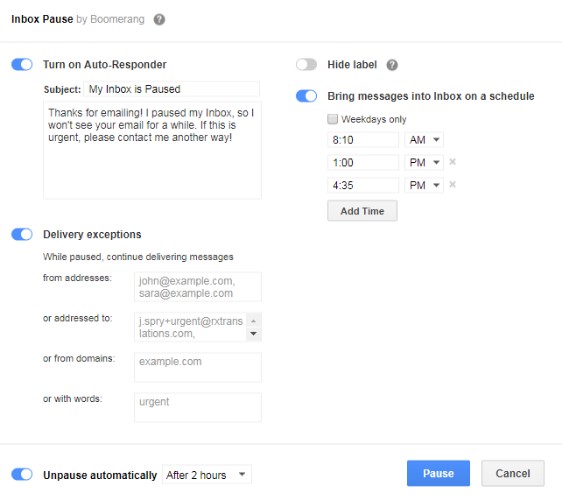Email is the double-edged sword of the business world. It allows communication with anyone at any time.
That’s also the problem. We can send and receive emails 24 hours a day, 7 days a week.
And it’s even harder in our industry. With the increasing globalization of business, especially within the translation and interpretation sector, there are no longer fixed “business hours.” Even if a person only operates on a 9-to-5 schedule, their 9-to-5 happens at a different time from someone else’s 9-to-5 halfway across the world.
An email in your inbox means that someone needs or wants some of your time. This can easily end up derailing your productivity if you try to spring to reply the second an email comes in.
So how do you remain in control when it comes to email? Use these three techniques.
1. Categorize all incoming email and follow up as needed.
Each morning, review your email and categorize it. Reply during the day at the time that works best for you. Trying to reply to email first thing in the morning can delay getting to actual work.
Try using the following labels to categorize messages in your inbox.
– Urgent: Action needed today.
This may include job or quote requests and inquiries about current jobs.
– Action required: Less urgent messages that require attention and are less time-critical.
This may include replies to someone’s request or a notification that something needs to be updated on a website.
– Action pending: Future action would be good.
This may include instances such as communication with someone who asked you to speak at an event that didn’t work for your schedule. You may want to follow up with this person to schedule a future speaking engagements.
2. Use canned responses for common email replies.
Ever feel like you always send the same few emails over and over again? Streamline that process!
Put together a handful of nicely worded emails that can offer detailed pricing information, replies to client objections, replies used for negotiations and other commonly-used responses.
If you no longer translate many handwritten projects, for instance, put together a template that explains that you are available but do not work on large projects in handwritten format.
If you frequently get emailed to handle projects outside of your specialization, come up with a template that politely declines your project and maybe even refers the sender to a trusted colleague.
One more productivity hack with Gmail accounts: You can use Gmail filters to create rules to set up canned automatic responses. For example, send auto-reply A when an email from domain X comes in and auto-reply B when an email from domain Y comes in. Rules also allow you to automatically mark certain messages as read or automatically apply a certain label.
3. Make Boomerang your personal email assistant.
Delegate keeping track of follow-ups to Boomerang. This email plugin allows you to manage email follow-ups and scheduling. The creator developed it after seeing the need for a more efficient way to manage email without it becoming its own full-time job.
Use Boomerang to:
-
Avoid cluttering your to-do list with entries about following up on unreplied emails. Have emails sent back if you don’t get a reply in a certain time period, such as 2 days, 3 days, etc.
-
Turn on read-receipts, especially helpful when delivering important jobs.
-
Put your inbox on pause and send out auto-replies. Manually turn on your out-of-office reply and set it to turn off automatically with Boomerang.
-
Set your inbox to only import new messages at certain intervals or times. Studies show that checking email too often can interfere with your productivity. Avoid the distraction that comes from constant email pop-ups and chimes.
Here’s a screenshot of the “pause” screen:
Give these tips a try to have email serve you, not the other way around.
Looking for more ways to streamline email and other business processes? Sign up by August 30 for the week-long online Success by Rx event running from August 30 through September 5.
Author: Melissa Kamenjarin
Melissa is a Success by Rx copywriter and Spanish/English translator, writer, editor and proofreader specializing in educational materials, health insurance, non-profits, and published fiction and non-fiction books, blogs and websites. Melissa is the Secretary and blog writer for ATISDA (Association of Translators and Interpreters in the San Diego Area). An American Translators Association (ATA) member, she is also the Copy Editor for the ATA Medical Division’s publication, Caduceus.



Good advice, Jenae! One productivity tool that’s quite useful is textexpander.com. You can create an extensive library of text snippets that pop up with just a few keystrokes.
Sorry, *Melissa (not Jenae). Oops!